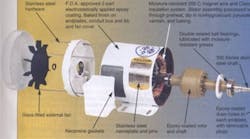For years, that equipment downtime scene was common in a chicken-processing plant or just about any place else electric motors found themselves in the path of regular high-pressure liquid cleaning. Maintenance people did what they could to keep water and condensation out of the motors, but sealers and caulks just couldn’t do it all. If nothing else, the motors failed from the inside out. Condensate built up and corroded the motors away if the windings didn’t blow first from all the water inside.
Motor makers responded based on the knowledge that the outside and inside of a motor needed equal protection; many motors were lost simply by water getting into the bearings. Also, rust and other internal corrosion products flaked off inside the motors and plugged condensate drain holes, after which motor life was pretty short.
Inside work
Washdown-duty motor makers have several ways of protecting motor internals. Invariably, they include help for the stator windings, the stator assembly, and the rotor and shaft. The windings themselves may be of special quality to serve in a moisture-laden internal environment. Also, the wound stator windings are generally inserted into the band of the frame, and then the assembly is treated by any of several methods so that all surfaces — internal and external — receive a moisture-resistant cover.
Before assembly of windings and frame, the frame itself had probably received a coating. That coating helps both the outside and inside of the frame. It may be an epoxy coating, electrostatically applied and then baked and fused at high temperature. Typically, the only parts of the frame not coated are those that are machined after coating to provide mating surfaces for other components. The rotor and the shaft also typically receive a treatment to prevent moisture attack there. Shaft and hardware may also be of stainless steel for further protection. Gaskets are used freely to keep high-pressure cleaning fluids out of the motor cavity.
Seals
On assembly of a typical washdownduty motor, sealant is applied at rabbets and screw heads. Extra sealing is provided where the shaft projects through the endplate. A slinger on the shaft, running outside a lip seal, provides extra protection by slinging water away from the shaft before it gets to the seal.
Inside the typical washdown-duty motor, sealed bearings fight early bearing failure. Bearing lubrication with a moisture- resistant grease helps keep liquids from the running surfaces of the bearing, avoiding surface rust and particles freed during corrosion.
Over the whole motor, a coat of white epoxy can add another degree of sealing. It can also provide a smooth surface to which food or other substances won’t stick. Fins could trap material, keeping the motor from being cleaned properly, so washdown-duty motors typically have smooth-band frames.
Avoiding condensate build-up
Some motors are fully self-contained or have motor cavities vented to a separate controlled environment. Such motors, however, are generally expensive, special-purpose devices for things such as dangerous atmospheres or high-vacuum use. Most motors, including washdown- duty motors, are not air-tight. When they are subjected to slight internal- external pressure differentials that come about because of a temperature change within the cavity, they try to “breathe.”
A motor cooling after shutdown, for example, has its internal air temperature dropping, thus trying to create a slight vacuum within the motor. Because the motor is not air-tight, external air leaks into it to equalize the pressure. That incoming air brings with it whatever it contained outside the motor: moisture droplets, or water vapor that condenses into liquid water when it hits the motor interior and its cooler surfaces.
To prevent damage from condensate and entrained droplets, a washdown motor must provide means to drain off. There are several types of devices to do the job. Be sure when you mount a washdown- duty motor in any orientation that any liquid in the cavity can reach the drain by gravity flow.
Stainless steel
The F.D.A. got tough regarding paint chips. Its contention: Bacteria can grow in chipped areas of painted motors. Even the best coatings can’t survive abuse such as vehicle collision or falling objects, and such things happen in processing plants. To beat that problem, there are now stainless washdown motors with stainless steel bands, fan covers, conduitbox covers, bases, and so forth.
Other materials can serve similarly, if they provide no bacterial growth points while avoiding corrosion. For example, some motors are provided with endplates of a special aluminum alloy and surface-finish process that requires no coating.
Bakery service
For the baking industry, motors similar to the white washdown motor are rated for service according to Baking Industry Sanitation Standards Committee (BISSC) requirements. Every bend is filleted to prevent material build-up in a sharp bend, fold, or crack. Typically the same internal and external protection is provided and the final finish is a glossy, smooth white.
The future
Washdown motors are finding homes in many applications outside food processing — wherever lots of water is splashed or directed on and over motors. For example, they have found their way to ventilation equipment on roof tops.
If there is water around and it causes a problem, washdown motors may solve it. And if bacteria growth in a chipped-paint area is no cause for concern, there probably is no reason to go to the expense of a stainless washdown motor.
Washdown motors have saved industry many thousands of hours of downtime, and motor manufacturers respond to the growing need. Today, you have many choices of vendors and motor styles. Those choices will continue to expand. Also, the washdown duty trend is extending to electric clutches and brakes, controls and sensors, and motor adjustablespeed drives.
Ted W. Atkins is Executive Vice President, Baldor Electric Co., Ft. Smith, Ark.


